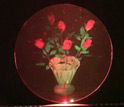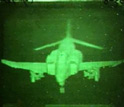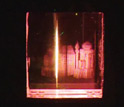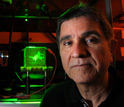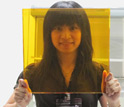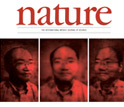News Release 10-207
The Emergence of Holographic Video
Experimental networked display refreshes holograms every two seconds

An image of an F4 Phantom fighter jet created with the new 3D telepresence system.
November 3, 2010
View a webcast with Nasser Peyghambarian of the University of Arizona and videos (video1, video2, video3, video4) of the holographic 3D display.
This material is available primarily for archival purposes. Telephone numbers or other contact information may be out of date; please see current contact information at media contacts.
Researchers at the University of Arizona (UA), Tucson, have developed a holographic system that can transmit a series of 3D images in near-real-time, a precursor to holographic videoconferencing.
The system incorporates a novel, photorefractive polymer--one that can rapidly refresh holographic images and is scalable for production--coupled to a unique system for recording and transmitting 3D images of individuals and objects via Ethernet.
Lead author Pierre-Alexandre Blanche and his colleagues from the university and Nitto Denko Technical Corp. of Oceanside, Calif., describe the breakthrough in the cover story of the Nov. 4, 2010, issue of Nature.
"This advance brings us a step closer to the ultimate goal of realistic holographic telepresence with high-resolution, full-color, human-size, 3D images that can be sent at video refresh rates from one part of the world to the other," says co-author and project lead Nasser Peyghambarian of UA and the Director of NSF's multi-institution Engineering Research Center for Integrated Access Networks (CIAN).
The researchers had previously demonstrated a refreshable polymer display system, but it could refresh images only once every four minutes. The new system can refresh images every two seconds; while not yet ideal for a display, the rate is more than one hundred times faster.
Additionally, using a single-laser system for writing the images onto the photorefractive polymer, the researchers can display visuals in color. While the current refresh rate for multi-color display is even slower than for monochromatic images, the development suggests a true 3D, multicolor system may be feasible.
"This breakthrough opens new opportunities for optics as a means to transport images in real time," says Lynn Preston, director of the NSF Engineering Research Centers program that supports CIAN. "Such a system can have an important impact on telepresence, telemedicine, engineering design and manufacturing, and other applications. This is an early and tremendously important outcome from this three-year old center."
More information is available in the UA press release.
This material is based upon work supported by the Engineering Research Center Program of the National Science Foundation under NSF Cooperative Support Agreement Award No. EEC-0812072
-NSF-
-
View Video
Peyghambarian of the University of Arizona describes an experimental 3D teleconferencing technology.
Credit and Larger Version -
View Video
A hologram of a member of Peyghambarian's lab appears in the photorefractive polymer screen.
Credit and Larger Version -
View Video
Holographic representation of a vase showing different colors capable with the new system.
Credit and Larger Version -
View Video
A pulsed laser inscribes a holographic image of a F-4 jet into the photo-refractive polymer screen.
Credit and Larger Version -
View Video
A laser inscribes a series of holograms into the photorefractive polymer screen.
Credit and Larger Version -
Study co-author and project lead Nasser Peyghambarian of the University of Arizona, Tucson.
Credit and Larger Version -
Team member Vivian Sieh holds up the photorefractive polymer.
Credit and Larger Version -
The cover of the Nov. 4, 2010, issue of Nature.
Credit and Larger Version
Media Contacts
Joshua A. Chamot, NSF, (703) 292-7730, email: jchamot@nsf.gov
Daniel Stolte, University of Arizona, Tucson, (520) 626-4402, email: daniel.stolte@gmail.com
Program Contacts
Lynn Preston, NSF, (703) 292-5358, email: lpreston@nsf.gov
Principal Investigators
Nasser Peyghambarian, University of Arizona, Tucson, (520) 621-6997, email: Nasser@optics.arizona.edu
The U.S. National Science Foundation propels the nation forward by advancing fundamental research in all fields of science and engineering. NSF supports research and people by providing facilities, instruments and funding to support their ingenuity and sustain the U.S. as a global leader in research and innovation. With a fiscal year 2023 budget of $9.5 billion, NSF funds reach all 50 states through grants to nearly 2,000 colleges, universities and institutions. Each year, NSF receives more than 40,000 competitive proposals and makes about 11,000 new awards. Those awards include support for cooperative research with industry, Arctic and Antarctic research and operations, and U.S. participation in international scientific efforts.
Connect with us online
NSF website: nsf.gov
NSF News: nsf.gov/news
For News Media: nsf.gov/news/newsroom
Statistics: nsf.gov/statistics/
Awards database: nsf.gov/awardsearch/
Follow us on social
Twitter: twitter.com/NSF
Facebook: facebook.com/US.NSF
Instagram: instagram.com/nsfgov





